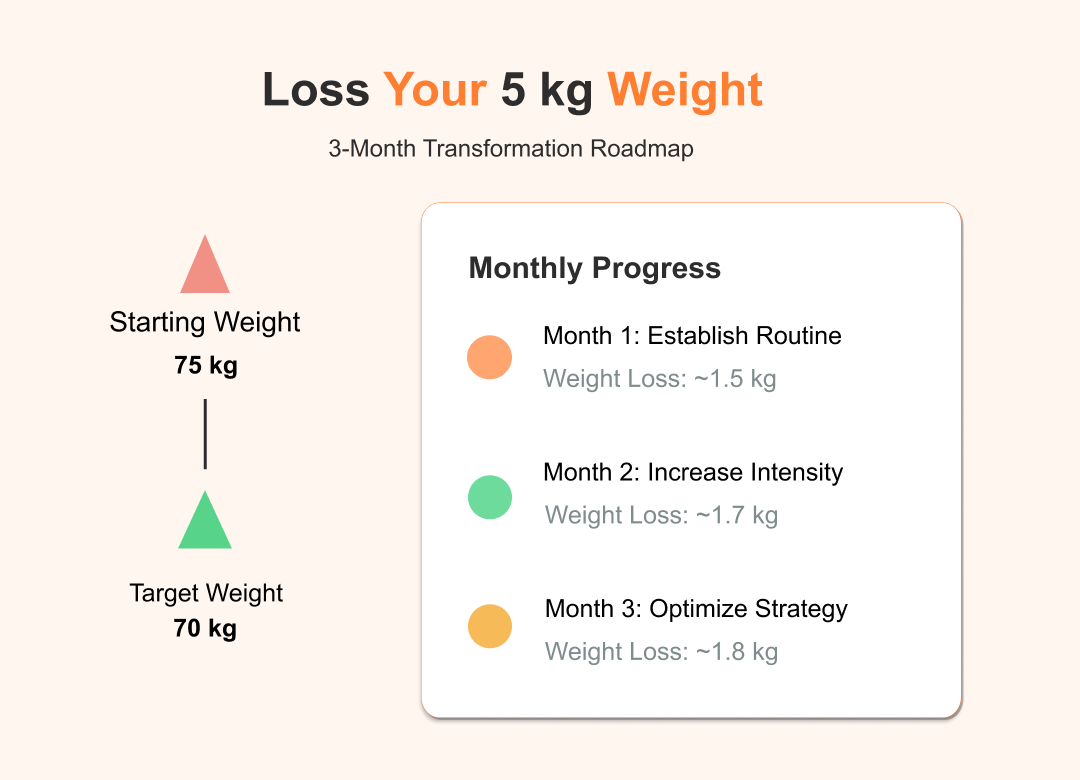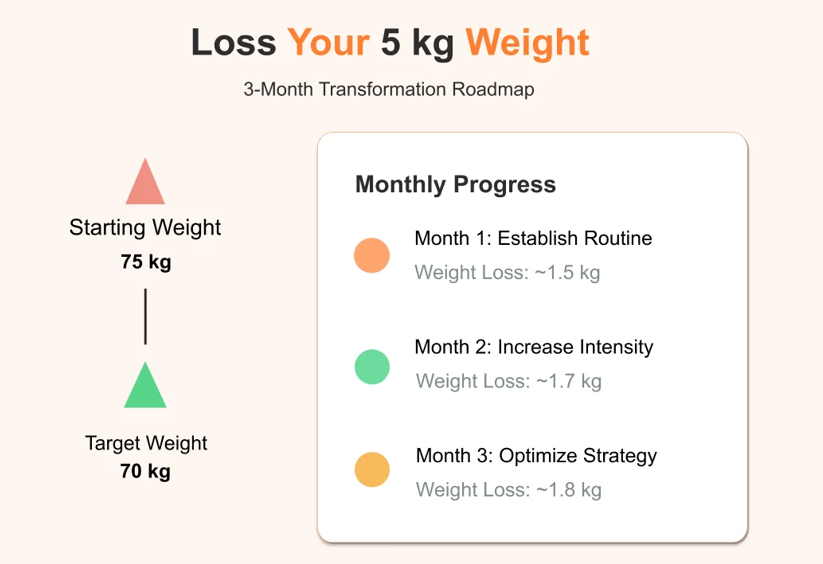Loss 5kg of Body Fat in 3 Months: The Realistic way
Losing 5 kg of body fat in 3 months sounds like a simple enough goal. But if you’ve tried and failed before—or are overwhelmed by all the conflicting advice out there—it’s easy to feel stuck. This guide will cut through the noise and give you a realistic, actionable approach that focuses on fat loss, not just weight loss, so you can see results and keep them for good
Let’s dive in, be honest about the mistakes holding you back, and map out a plan that works
What Does Losing 5 kg of Fat Actually Mean?
Before we start, let’s get one thing straight: losing 5 kg of body fat isn’t the same as losing 5 kg of weight. When you step on a scale, the number reflects everything—water, muscle, and fat. But fat loss is what improves your health, energy, and appearance
To lose 5 kg of fat, you need a deficit of roughly 35,000 calories (7,000 calories per kg). This might sound daunting, but over 3 months, it breaks down to a sustainable 385-calorie deficit per day
- Why focus on fat loss? Because losing muscle and water weight can leave you weaker, slower, and more likely to regain weight quickly. Fat loss preserves your lean muscle and gives you long-term results
Is It Realistic to Lose 5 kg in 3 Months?
Absolutely! In fact, this is one of the healthiest fat-loss goals you can set. Aiming for 0.5 to 1 kg of fat loss per week aligns with the guidelines for sustainable, long-term results
But what if you’re thinking, “Can I lose more?” Yes, it’s possible to lose more than 5 kg in 3 months, but aggressive dieting and extreme exercise plans often backfire. Rapid weight loss can lead to muscle loss, hormonal imbalances, and even a slower metabolism
Stick to a plan that works with your body, not against it. Trust the process—it’s better to lose 5 kg sustainably than to lose 10 kg and gain it all back

Diet: The Key to Fat Loss
Fat loss starts in the kitchen. Creating a calorie deficit doesn’t mean starving yourself—it means being smarter about what you eat
- Eat whole foods. Prioritize lean proteins, whole grains, fruits, and vegetables. They keep you full longer and provide the nutrients your body needs
- Avoid processed foods. These are calorie-dense but nutritionally empty, making fat loss harder
- Focus on portion control. Even healthy foods can lead to weight gain if eaten in large quantities
Example:
If your daily calorie requirement is 2,000, aim for 1,600–1,800 calories per day to maintain a steady deficit. Pair this with regular exercise, and you’ll consistently lose fat

Exercise: Burning Fat and Building Strength
While diet is king, exercise is essential for preserving muscle and accelerating fat loss
- Strength training: Build muscle to boost your metabolism and burn more calories, even at rest
- Cardio: Activities like running, swimming, or cycling help burn calories and improve heart health
- Walking: A simple, low-impact way to create a calorie deficit without overexertion
Pro Tip: Combine strength training 3–4 times a week with moderate cardio for optimal results
What If You Have Unique Challenges?
“I have PCOS or thyroid issues. Can I still lose fat?”
Yes, but it may take more time and patience. Conditions like PCOS and hypothyroidism can affect metabolism, so you’ll need a tailored approach. Focus on nutrient-dense foods, balanced hormones, and sustainable exercise
How to Measure Progress Without Obsessing Over the Scale
Relying solely on the scale can be misleading. Your weight can fluctuate daily due to water retention, digestion, or hormonal changes
Instead:
- Use a tape measure to track changes in your waist, hips, and thighs
- Take weekly progress photos
- Pay attention to how your clothes fit and how you feel
This holistic approach will help you stay motivated, even when the scale doesn’t budge
Why Fat-Loss Plateaus Happen and How to Overcome Them
At some point, progress might slow down. This is completely normal and happens to everyone
Here’s why:
- Your body adapts to calorie deficits over time
- You might be underestimating your calorie intake or overestimating exercise
How to break through a plateau:
- Reassess your calorie intake and adjust as needed
- Add variety to your workouts to challenge your body in new ways
- Prioritiase sleep and stress management, as both can affect fat loss

Do You Really Need Supplements or Shortcuts?
The truth: You don’t need fat burners, detox teas, or expensive supplements.
Supplements like protein powder or omega-3s can support your journey, but they’re not magic solutions. Focus on the basics—diet, exercise, and consistency—and save your money

A Realistic 3-Month Fat-Loss Roadmap
Month 1: Build the Foundation
- Focus on diet: Eliminate processed foods and track calories
- Start light exercise: Add 2–3 strength-training sessions and daily walks
Month 2: Increase the Intensity
- Refine your diet: Adjust portions if needed and increase protein intake
- Add variety to workouts: Try interval training or group classes
Month 3: Push Through Plateaus
- Monitor progress and adjust calorie intake or workouts if needed
- Focus on consistency and celebrate small wins
Maintaining Results After Fat Loss
Once you hit your goal, the real work begins: keeping the fat off
- Transition to a maintenance phase by gradually increasing your calorie intake
- Continue regular exercise and healthy eating habits
- Focus on sustainable, enjoyable routines to prevent weight regain
A Final Word: Why 5 kg Is Just the Beginning
Losing 5 kg is a fantastic achievement, but the benefits go far beyond the number on the scale. You’ll feel stronger, healthier, and more confident—and you’ll have built habits that can last a lifetime.
The journey isn’t about perfection—it’s about progress. Start small, stay consistent, and trust yourself to succeed.

